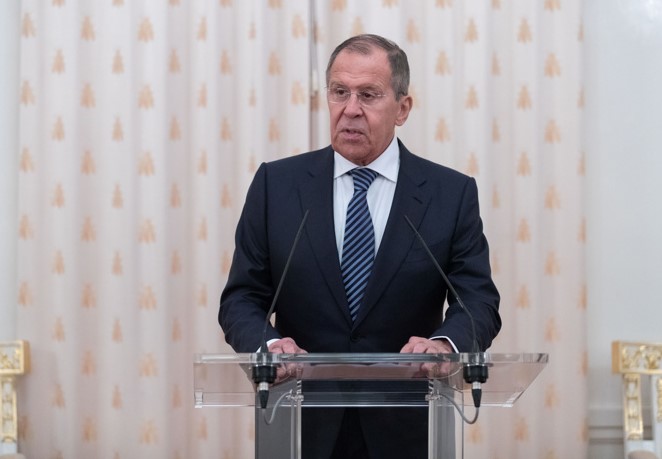Last week saw the euphoric celebration marking the fiftieth anniversary of the creation of Bangladesh. While pages and bytes, and rightfully so, we're devoted to India's contribution to the historical event, less discussed was the role of the Indo-Soviet Treaty of Peace, Friendship and Cooperation, the signing of which in 1971 played a major role in ensuring the victory of the Indian forces together with the Mukti Bahini. This may not come up in discussions that the Russian Foreign Minister Sergei Lavrov, who is visiting India for a day, may have with his Indian counterpart S. Jaishankar, but it marks an important chapter both in India's history and in the history of bilateral relations.
Lavrov's visit is coming at a particularly trying time in bilateral ties. According to the Ministry of External Affairs, during his meeting with Dr Jaishankar and possibly even with Prime Minister Narendra Modi, Lavrov will be discussing "important aspects of bilateral ties", "review preparations for the next India Russia annual summit and also
perhaps (will) discuss regional and international issurs of mutual interest". But Lavrov's visit is coming at a particularly trying time in bilateral ties.
There are misgivings on both sides: on the Indian side over its exclusuon from the 'extended troika' talks in Moscow on Afghanistan last month, Russia's strong embrace of China, and tilt towards Pakistan. On the Russian side the misgivings are mostly about India's embrace of the Quad – voiced by the minister himself – and perceived tilt away from Russia.
All these concerns need to be allayed because in an ever-changing world Indo- Soviet/Russian ties have, with the occassional hiccup, endured. Russia has been a trusted friend for too long. Besides the obvious suuport – on Kashmir, in the UN Security Council, in defence – new vistas of cooperation have opened up.
The recent blockade of the Suez Canal for instance, has reinforced the sagacity of developing the International North South Transport Corridor (INSTC), in which Russia and India are key participants and the Russian Federation becomes India's gateway to Europe.
The recent Iran-China strategic agreement and increasing Chinese influence and presence in Central Asia and Eurasia nesecitates greater indo-Russisn cooperation. It is no secret that Western sanctions on Russia since 2014 drew it closer to China, but tensions remain in bilateral Sino-Russian ties. Consequently, another horizon of
cooperation has opened up in Russia's Far East. While India has pledged $1billion credit line to the development of the region, Indian investments can balance the vast Chinese presence there, again a potential source of tension.
Investments in Russia's Far East will also seek to reinvigorate sluggish trade relations between the two sides which currently fall far short of their potential. To that end the Vladivostok-Chennai maritime corridor agreement is promising.
On the eve of his visit to Vladivostok to attend the economic summit in 2019 Modi, in an interview to the Russian media had also pitched for Indian labour in the Russian Far East, a possible alternative to the saturated GCC labour market.
India has also consistently pitched for Russia's inclusion in the Indo-Pacific (a concept that worries the Russians), with Russia forming part of India's "Look Far East" policy. Which brings us to India's participation in the Quad.
We cannot wish away the friction between India and China, and India's inclusion in the Quad, is at best to act as a pressure point on Chinese expansionism in the Indo-Pacific. But even American analysts recognise that the idea of a military alliance would be anathema to India. At the same time, Russia has played a constructive role in cooling temperatures between India and China, both in 2017 during the Doklam crisis and more recently during the Ladakh stand-off.
Both Defence minister Rajnath Singh and External Affairs Minister Jaishankar met their Chinese counterparts in Moscow following the clashes. And it was Russia that facilitated India's entry into the Shanghai Cooperation Organisation, a valuable platform for India's outreach to Central Asia. While, along with Quad, India continues to be a member of the BRICS group.
India is also resolutely adhering to it's decision to procure the S400 missile system from Russia, (a topic slated to come for discussion during Lavrov's visit), notwithstanding US pressure to rescind the deal and the imposition of sanctions on Turkey for a similar purchase. Such defence ties, including joint production,
remains a cornerstone of bilateral relations, and ensuring long term cooperation and interdependence. This in turn acts as a hedge for any geo-political risks that forms ne side may percieve from another.
Cooperation in the nuclear and energy sectors are also important pillars of Indo-Russian cooperation, extending to cooperation in third countries. As India seeks to diversify it's crude basket, imports from Russia are set to increase.
Not to forget cooperation in space (3rd April marked the 37th anniversary of the flight to space of Rakesh Sharma – India's first man in space from the then Soviet Baikonur space station). Geographically Russia is close without being too close for comfort. On almost all international affairs there is convergence between both
sides. Even on Afghanistan – which will be a topic of discussion – India can partner with Russia. India is also set to produce Russian Sputnik V covid vaccines in far bigger quantities than have been produced in Russia.
In a word, India-Russian ties are all encompassing, that have stood the test of time. They must remain so.




















